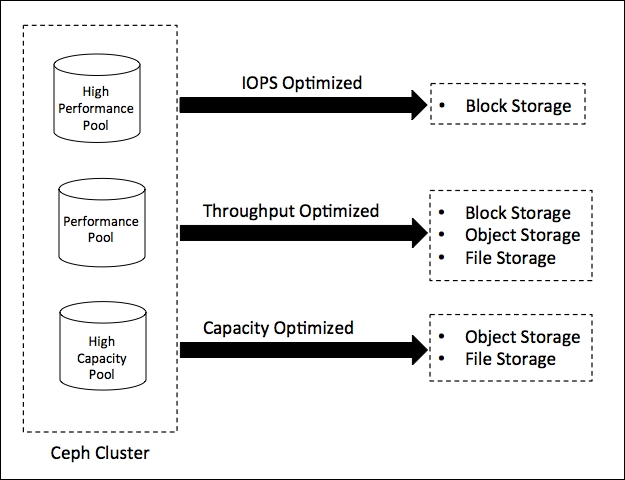Ceph is a software-defined storage solution that is designed to run on commodity hardware. This ability of Ceph makes it a flexible and economic solution that is tailored for your needs. Since all the intelligence of Ceph resides in its software, it requires a good set of hardware to make it an overall package that is a great storage solution.
The Ceph hardware selection requires meticulous planning based on your storage needs and the use case that you have. Organizations need optimized hardware configurations that allow them to start small and scale to several petabytes. The following diagram represents a few factors that are used to determine an optimal configuration for your Ceph cluster:

Different organizations have different storage workloads that generally require some middle-ground shared by performance, capacity, and TCO. Ceph is a unified storage, that is, it can provision File, Block, and Object storage from the same cluster. Ceph is also able to provision different types of storage pools within the same cluster that are targeted at different workloads. This ability allows an organization to tailor its storage infrastructure as per its needs. There can be multiple ways to define your storage needs; the following diagram shows one way of doing this:

- IOPS Optimized: The highlight of this type of configuration is that it has the highest IOPS (I/O operations per second) with low TCO (Total Cost of Ownership) per IO. It is typically implemented using high performance nodes containing faster SSD disks, PCIe SSD, NVMe, and so on, for data storage. It is generally used for block storage, however, you can use it for other workloads that require a high IOPS.
- Throughput Optimized: Its highlights include the highest throughput and low cost per throughput. It is typically implemented using SSD disks and PCIe SSD for OSD journals, with a high bandwidth, physically separated dual network. It is mostly used for block storage. If your use case requires a high performance object or file storage, then you should consider this.
- Capacity Optimized: Its highlights include low cost per TB and low cost per rack unit of physical space in the datacenter. It is also known as economic storage, cheap storage, and archival/long-term storage, and it is typically implemented using dense servers full of spinning disks, usually 36 to 72, with 4 to 6 TB of physical disk space per server. It is generally used for low cost, large storage capacity object or filesystem storage. It is a good candidate to use erasure coding to maximize the usable capacity.
